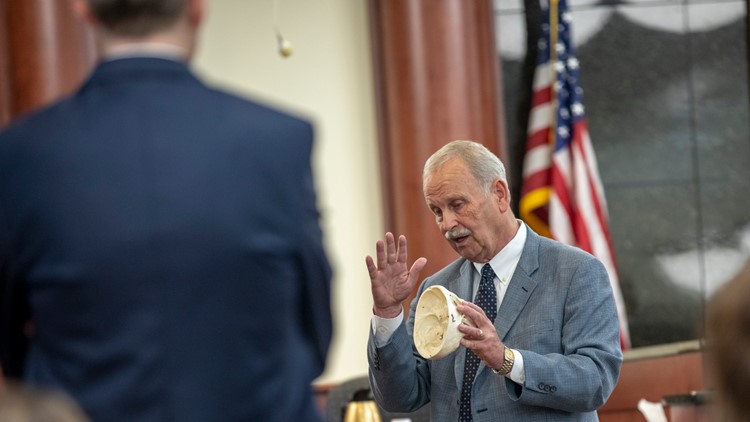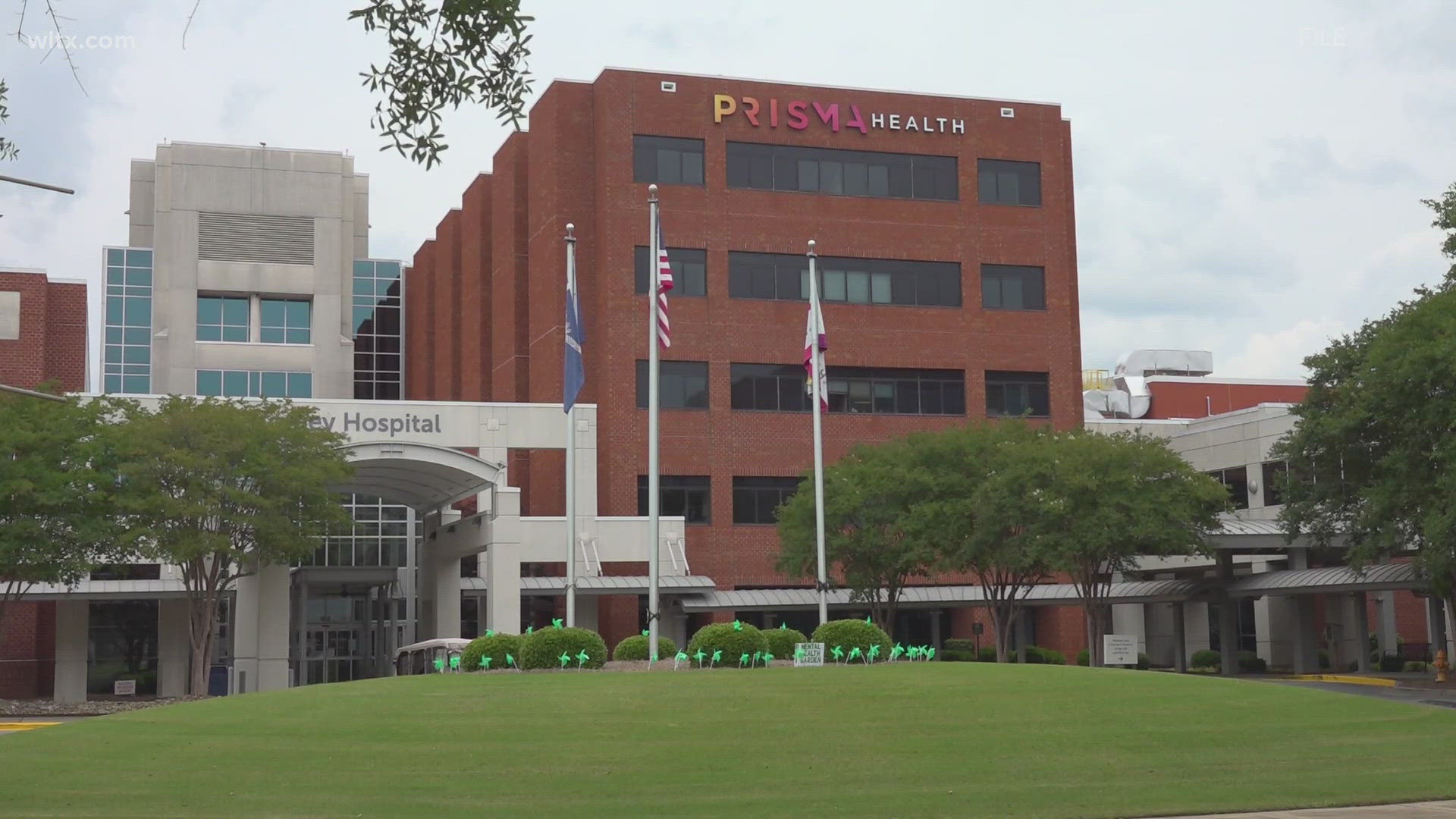LEXINGTON, S.C. — Jurors heard from a brain expert who said Timothy Jones Jr., the man charged with killing his five children, had long-term brain injuries.
It came during as the defense continues to make the case that Jones is not guilty by reason of insanity. The Lexington father is accused of killing his five children in August of 2014 before dumping their bodies in Alabama. He was eventually arrested in Mississippi.
Prosecutors are pushing for the death penalty.
Friday morning testimony in the Tim Jones murder trial at the Lexington County Courthouse began with the defense getting through just one witness before lunch.
Dr. Erin Bigler, a retired professor from Brigham Young University, is a clinical neuro-psychologist — one of his specialties is to interpret brain imaging records and give expert testimony in the field of neuro-psychology.
Bigler became involved in the Tim Jones case after Dr Bushawn Aghakar (who testified on Thursday) asked him to review MRI scans of Jones via volumetric analysis.
Bigler in turn, after noticing significant traumatic brain injury, decided to enlist the services of a neuro-radiologist, Dr Travis Snyder (taped testimony entered into evidence on Thursday)
Immediately, Bigler noticed abnormalities in Jones’ brain and skull. From supplied MRI and raw data, Bigler created a 3-D rendering of Jones’ brain.
Bigler used an actual human skull and a model of the brain as visual aids to present his findings to the jury.
He began by explaining the interworkings and structure of the brain — pointing out the two hemispheres and the inter-hemospheric; the corpus callosum that connects two sides of the brain; the base of the brain (frontal and temporal lobes);.
Bigler explained that a fracture or defect to the skull will defect or damage the brain; that the brain very jello-like and impact can effect the opposite side of the brain as well as the original area of impact. This is the coup (original) and contrecoup (opposite) injuries.
The doctor pointed out that normally the skull bone is quite small and narrow and the brain is nestled close to the skull with thin outer membrane protecting it. Therefore a depressed area of the skull effects the brain near damaged area.
Inside the skull, the bone surface of skull not smooth, this also makes the brain susceptible to injury.
On the provided scans, Bigler saw areas of Jones’ brain that had been injured.
One of the scans shows an image taken at the lateral ventricle (near eye level) of skull/brain. Bigler points out the left area of Jones’ brain has flattened out in comparison to right side, and shows old hemorrhagic damage. The doctor says healthy brain should be symmetrical, each side a mirror image.
Bigler explains more about the temporal lobe: the ventricle cavity is filled with cerebral spinal fluid to pressurize the brain inside the skull; if brain is abnormally shaped, the cavity may change size. Jones’ temporal horn of the lateral ventricle is substantially larger than the “normal” right side, and shape if hippocampus is different right and left; these areas of the brain are critical structures for the emotion signals in brain.
Bigler says that one tends to see changes in the frontal lobe and hippocampus in schizophrenics. He says tha schizophrenia is a brain disorder, not a mental illness happening independent of the brain.
Defense attorney Boyd Young begins a more detailed line of questioning: Does Jones have a brain defect?
Bigler: Clearly.
Bigler then describes formation of a human from egg to birth; that the brain responds to genetic factors, environment, and is experience-dependent. Health issues, poor diet and other environmental factors can effect brain adversely.
A brain injury at age 15 — such as Jones’ — will disrupt maturation of brain…the adult brain forms at age 25.
Bigler explains synapsis won’t form, there is a thinning in cerebral cortex. The brain is designed to attempt to heal itself and adapt, (what doctors call equi-potentiality). Bigler’s analogy — if a road is closed, there’s usually a work around — same in brain, a re-routing or accommodation with built in redundancies.
The areas damages in Jones’ brain:
- Frontal lobe: controls executive function, problem solving, emotional regulation;
- Temporal: controls emotional regulation and cognition; not sensory or mobile issues
- Behavioral issues from injuries: regulate mood, highs and lows, inappropriate behavior in social situations; will follow routines rather than adapt to change; disinterest, lack of motivation and drive; can effect intelligence;
Young: Someone with these injuries can go to college, get a job?
Bigler: Yes… With rigidity of a given situation or routine, a person with brain damage can seem normal. Organic personality disorder comes from having a brain injury, not a traditional personality disorder. Every behavior has an anatomy, all actions/thoughts/behavior goes back to basic function of the brain.
A broken brain = no longer normal
On cross-examination Solicitor Rick Hubbard asked: You are not here to tell jury that Jones’ traumatic brain disorder caused him to kill his kids
Bigler: No
Hubbard: None of the slides will show “here is a man that kills”
Bigler: No
Hubbard: There is no anatomy in the brain of a man that kills kids
Bigler: We can show an injury…. I cannot specifically answer that question
Hubbard: You cannot say Jones knew right from wrong
Bigler: Not here to address that question
Hubbard: didn’t see in your report where you took any information from other that what was given to you by defense. Dr Kimberly Cruise tested for underlying psychosis
Bigler: My role to test for brain injury
Hubbard: Aware Cruise found nothing to suggest schizophrenia?
Bigler: No
Hubbard: Dr Richard Frierson, court appointed psychiatrist found no schizophrenia
Bigler: No
Hubbard: Only persons to say “schizophrenia” come from other side of courtroom
Bigler: Yes
Hubbard: You cannot tell from a slide what someone will do in life; not everyone with trauma brain injury will have schizophrenia
Bigler: No
Hubbard: Did you know that right after this incident in high school — before and after, Jones was outperforming students in school, district
Bigler: The higher functioning you are before injury will influence recovery; there is evidence of significant cognitive recovery in Jones’ brain
Hubbard: Did you know that during Jones’ life at school, he was working multiple jobs, raising a family; still had job performance reports that he excelled in working with others in competitive environment at Intel, that there were no complaints from coworkers on Jones' behavior?
Bigler: I did not have that information
Hubbard: Basically everything you know about Tim Jones was provided by the people that hired you. Nothing in your slides answers the question that the jury has to answer whether the defendant knew right form wrong or appreciated on night of incident (of August 28, 2014)
Bigler: I can only show he has a broken brain
Defense attorney Young on re-direct: The state appointed psychiatrist diagnosed Jones with…
Bigler: A bipolar type issue
Young: As a clinician, knowing Jones’ family history of schizophrenia, the brain scans showing atrophy, auditory hallucinations….
Bigler: A physiologist and psychiatrist working together would be able to form a straightforward conclusion
Prosecutor Hubbard has the last question — about Bigler’s roll as interpreter of MRIs and the information provided to him by the defense team including a self-diagnosis of schizophrenia by Tim Jones Jr.
Bigler: Imaging is objective. A diagnosis based on self-reporting needs clinical correlation.



